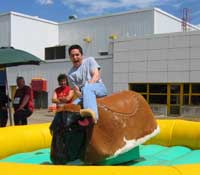IKEA France: a follower of recruitment by simulation
For their new store in Franconville, Ikea has used an original ANPE (French National employment office) program.
Recruitment is done by simulation. For its sixth store in the Paris region which opened a year ago in Franconville (a Paris suburb) Ikea turned to an atypical hiring method. Three quarters of the 420 employees at the new store were recruited according to a “recruitment simulation method ,” designed by the ANPE, and has therefore even branded the name. Banished are classic CVs and cover letters. Here, they prefer analyzing skills. The ANPE talks in terms of individual’s “skills,” depending on the job aimed for.
In one month, 3 500 people replied to the call for candidates. Last October, candidates, in small groups, were first informed of the positions available and the particular Ikea requirements, such as Sunday openings. Then came the first written test establishing minimum knowledge of the person. Maryvonne Le Liboux, departmental director at the ANPE of Val-d’Oise, which piloted the precise operation “It is at the second interview that we test skills, defined specifically with Ikea, for each position,” she continued: constructing objects from Lego type pieces within a time limit, to evaluate spatial awareness, multiple choice questionnaires on welcoming customers. In the last stage, the applicants have to role play the position they are applying for. How else can you control the situation faced with a cranky or hot-tempered customer…
Priority aptitudes in recruitment.
“To hold on to a job these days you need knowledge, of course, but you also need skills” claims Maryvonne Le Liboux, responsible for the ANPE recruitment simulation mission. These “skills” are all the abilities developed within or outside our professional lives, which do not necessarily come across in a CV, but which are necessary for taking on a job. “There are five skills particularly sought by companies,” points out Maryvonne Le Liboux, “knowing how to communicate, work in a team, adapt oneself, work under pressure and produce controlled and quality work.”
The method: simulation exercises.
“These are recruitment tests recreated to replicate the skills necessary for the job” indicates  the ANPE. The positions are recreated and validated by existing employees. Each candidate carries out (alone or in a group) a task with an ensemble of set instructions: they must strictly follow the instructions and obtain a precise result, in terms of the organization and decision making. At this stage they can therefore show their skills for the job. If they give satisfactory results they will pass to the interview stage. If they are hired, they can benefit from training.
the ANPE. The positions are recreated and validated by existing employees. Each candidate carries out (alone or in a group) a task with an ensemble of set instructions: they must strictly follow the instructions and obtain a precise result, in terms of the organization and decision making. At this stage they can therefore show their skills for the job. If they give satisfactory results they will pass to the interview stage. If they are hired, they can benefit from training.
Convincing results
Since 1995, 40 000 people have been hired by this method, 9 600 alone in 2005, 1 000 of which were young people. Generally, large companies use the method (Airbus, Boeing, PSA, Leroy-Merlin, France Telecom…), but smaller companies are also being tempted. The method is fuelling more and more interest, in particular faced with large recruitment jobs or to overcome the shortage in the workforce. 56% of candidates pass the evaluations which take place on the vocational platforms targeted in terms of professions. For example, in the 20th arrondissement in Paris, young people are evaluated in hotelier jobs, catering and security. Eventually, each profession will have their own.
Less discrimination?
Thanks to this method, people who are not usually sought by companies have a chance to be selected. For example: unqualified youths, women in traditionally male jobs, long-term job seekers, self-educated persons, handicapped people, seniors…The method can also reduce various forms of discrimination while preserving recruiter’s professional requirements.